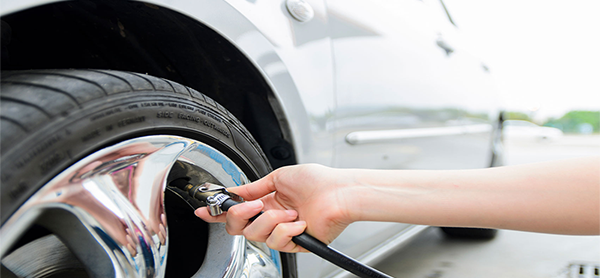Tire Pressure
Why should you check your tire pressure often?

- Save Money : When a tire is over inflated or under inflated, the tire wears out far faster which means that you will have to buy new tires more often. By keeping your tire pressure regular, you can extend your tier's life by an average of 7500 km. With that extra life, you could drive from Toronto all the way to Calgary . . . and back!
- Comfort : Your tire pressure influences the handling and performance of the vehicle. If you have noticed a decline in the responsiveness of your vehicle while driving, it could be your tire pressure.
- Safety : Under/Overinflated tires can be dangerous on the road, especially when going around sharp turns. Stopping distance and directional stability are negatively affected, and blowouts become more likely, increasing the chance of an accident.
How do you check your tire pressure?
- Find the car's handbook : It will have the recommended tire pressure for your front and rear tires. There will likely be two figures; one for normal loads and the other for full loads.
- Check your tire pressure : Use a tire gauge to check the tire pressure. To do this, remove the end cap on the tier's air valve and press the gauge onto the valve stem until the sound of air escaping stops. Read the PSI reading on your gauge and compare it to the manufacturer recommendation.
- Adjust the tire pressure : If the reading is above the manufacturer's recommendation, let some air escape the valve stem to relieve the pressure. If the reading is below the manufacturer's recommendation, use an air compressor, which can be found at most gas stations, to fill the tire with air until the reading matches the recommendation. Replace the valve cap tightly back onto the stem.
Tread Depth

Tread depth is incredibly important when it comes to how safe you are on the road. The tire tread is what grips the road as you drive, but if it is not deep enough, your car loses traction and has extended braking times. As a regular part of vehicle maintenance, it is important to check your tread depth to determine when you may need to change your tires.
A tire is considered "worn out" when the tread depth is less than 2/32nds of an inch. You can measure that through a tread depth gauge, or, if you don't have one, then there is a simple test to see if your tire needs to get replaced. Take a quarter and place it in the tire tread in various places around the tire with the Queen's head facing down. If any part of the Queen's head is visible, then you have 2/32nds or less of an inch of tread depth remaining and need to replace your tires.
Balancing Tires
Balancing tires regularly ensures that weight is distributed equally around the circumference of the tire which helps to eliminate uncomfortable vibrations when driving and extends the life of your tires. It is recommended that your tires are balanced every 5000km-10000km, or after 1-2 years (whichever comes first).
Signs of Imbalance
If you notice any of these signs, even if the tires are relatively new, then it is possible that you have an imbalanced tire.
- You experience vibration at high speeds.
- There's uneven wear on the tread.
- There are suspension issues.
- There's an increase in fuel consumption.
Storing Tires
Whether you are switching to your winter or summer tire set, something that you must keep in mind is how and where you will store your off-season set. Direct Tire offers to store your tires for a small fee at its physical locations, so if you are looking for a safe and convenient place to store your tires -- look no further! However, if you are looking to store them yourself, there are some things that you should do to extend the life of your tires.
- Clean them! : Use some soap, water, and a tire brush to clean your tires before you store them. This will help to clean up the dirt that has been accumulated throughout the season rather than set in and harden during its time in storage.
- Choose a Location to Store Them : Find a dry, cool place to store them away from the sun. This could be areas such as your basement. Try to keep the tires away from any heat sources.
- Position the Tires : There are three practical options that you can choose from when deciding how to position your tires which include stacking, hanging, and standing them upright. Standing them upright puts the least stress on the tires, but it takes up the most space. So, if you choose to stack them, try not to stack them too high. Hanging your tires can be a good option as well, but never hang unmounted tires as it can cause the tire to become distorted and damaged.
- You're Done! : The tires will stay there for the remainder of the off-season, and when you need to change your tires again, just bring them over to us for your professional installation!
